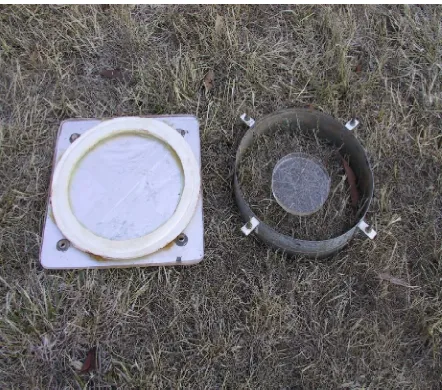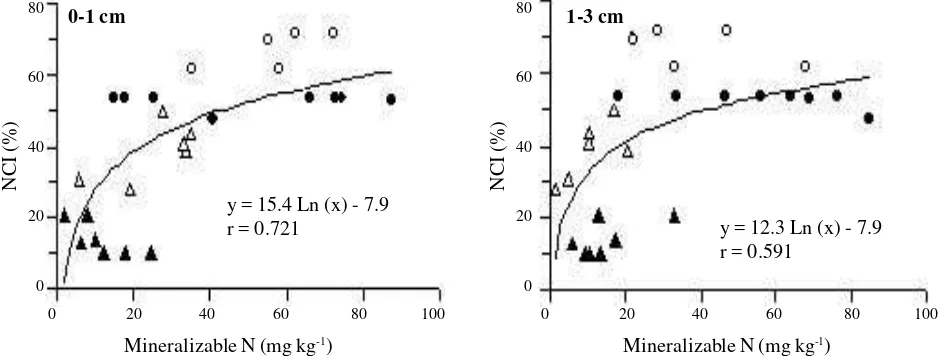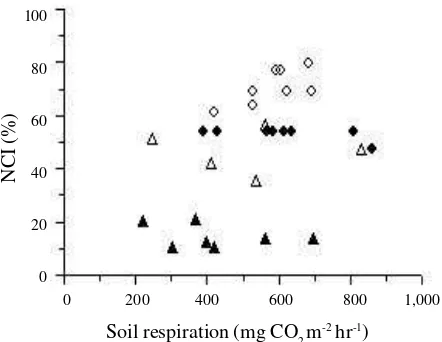J Trop Soils, Vol. 16, No. 3, 2011: 219-223
Nutrient Cycling Index in Relation to Organic Matter and Soil
Respiration of Rehabilitated Mine Sites in Kelian, East
Kalimantan
Dwi Setyawan1, Robert Gilkes2 and David Tongway3
1Department of Soil Science, Faculty of Agriculture, Sriwijaya University
Kampus Indralaya Km 32 Ogan Ilir South Sumatra, Indonesia. Phone/fax: +62711 580460, e-mail: [email protected]
2School of Earth and Geographical Sciences, The University of Western Australia, Crawley WA 6009.
Phone: +618 6488 2509, fax +618 6488 1050, e-mail: [email protected]
3School of Environmental and Rural Science, The University of New England, Armidale NSW 2351,
Australia. Phone/fax: +61 2 6254 7162, e-mail: [email protected]
Received 4 December 2009 / accepted 20 May 2011
ABSTRACT
Degraded soils at mine sites are often associated with decreased soil fertility. However, soil nutrient status might be improved through biomass recovery primarily from re-vegetation. This paper relates nutrient cycling index (NCI) derived from Landscape Function Analysis (LFA) to soil respiration and soil organic matter as a measure of improving soil condition after rehabilitation. Fieldwork was conducted at Kelian Equatorial Mining, East Kalimantan in June 2001. Four sites were selected representing rehabilitation work in 1994 (7 year), 2000 (1 year) and 2001 (3 month), and a reference site of undisturbed primary forest. The NCI value was calculated from scores of basal/canopy cover, litter (abundance, origin and degree of incorporation), cryptogam cover and surface roughness. Soil respiration was measured using the inverted-box method. In general, the NCI values increased with age of rehabilitation (12 to 56 %) showing a significant increase compared with the values of reference site (80%). Soil respiration varied greatly and the values were equally high (200-800 mg CO2 m-2 hr2) across all sites. Tropical soils like those of
Kelian might be inherently rich of soil organism as shown by high value of soil respiration. Nevertheless, the NCI values were not systematically related to soil respiration. We found that increased organic matter may be used as early sign of functioning soil resources in degraded land.
J Trop Soils, Vol. 16, No. 3, 2011: 219-223 ISSN 0852-257X
INTRODUCTION
DOI: 10.5400/jts.2011.16.3.219
Keywords: Gold mining, nutrient cycling, organic matter, respiration
Mine site rehabilitation is essential to restore soil fertility after disturbance. Methods used for soil restoration may include geo-technical measures, vegetative, or in combination with other techniques depending upon stages of mining operation. Mining operation in a tropical area may be exposed to severe erosion due to much higher rainfall than in a temperate region. Therefore, land rehabilitation aims to reduce soil and erosion in the early stage. In addition, rehabilitation also improves both soil fertility and soil organism.
High precipitation in the tropical areas, on the other hand, may act as a trigger (pulse) for rapid
plant growth (Ludwig et al. 1997). As a result, high
stand plant community may be achieved more rapidly. Likewise, litter and soil carbon turnover may be high under a tropical condition. Litter accumulation is the first visible sign of soil recovery. A congruent development of soil microbes may also occur which is able to promote nutrient release of decomposing organic matter.
To assess this progress, there should be a set of soil indicators that can be applied as simple, rapid but reliable in the field. There is a wide range of methods available for this purpose, for example a method that was eveloped by Andersen and Sparling (1997). In particular, the landscape function analysis (LFA) which was developed by Tongway and Hindley (1995). Originally this method was developed for tropical grasslands in Australia. However, it has been adapted for mine sites
(Tongway et al. 1997; Setyawan et al. 2002). The
for assessing soil surface conditions. Potential soil fertility is estimated by nutrient cycling index (NCI) under this protocol (Tongway et al. 2003). It is estimated that soils with high NCI values will correspond with more functioning soil resources. Activity of soil organism can be approached by measuring soil respiration.
This paper describes relationship between nutrient cycling index, soil respiration and soil carbon at rehabilitated mine sites in a tropical area.
MATERIALS AND METHODS
Study site
Fieldwork was conducted at the Kelian Equatorial Mining (KEM) site which is about 180 km north-west of Samarinda, the capital city of East Kalimantan Province. It is about 3 km south of the Equator (approximately 0°05¢S, 115°30¢E). Mining operation is focused at the Prampus hill prospect near the Kelian River. Altitude is around 250 m above sea level. The area has a typically tropical environment with rainfall in excess of 3,500
mm yr-1 distributed mostly in September-March.
Rainfall has caused a high variability in flow rate of the Kelian River ranged from 2 to 400 m3 s-1.
Local relief is deeply dissected sloping areas with steep-sided ridges and valleys and riverbed on flat
lands (Eaglen et al. 1998).
LFA Procedure and Soil Sampling
Four sites were selected representing locations which were rehabilitated in 1994 (7 year), 2000 (1 year) and 2001 (3 month), and a reference site of primary forest uphill of the Namuk dam (Setyawan 2004). At every site the soil surface conditions were assessed and sampling points were located along a down-slope transect. The number of sampling points differed between sites and in total there were 26 sampling points. From each sampling point, soil samples were collected from four depths (0-1, 1-3, 3-5 and 5-10 cm) that had a total number of 104 samples.
Soil surface assessment was conducted using landscape function analysis (LFA) as described by Tongway and Hindley (1995). For this presentation, only nutrient cycling index (NCI) in used. Scores for calculation of this index were derived from 1) basal cover of perennial grass or canopy density of trees and shrubs (score 1-4), 2) litter cover, origin and decomposition (score 1-30) 3) cryptogam cover (score 1-4), and 4) surface roughness (score 1-5). The NCI was the obtained score divided by total score (43).
Soil Respiration Measurement
Soil respiration estimates soil microbe activity through entrapment of produced carbon dioxide
(CO2) during metabolism. It can be conducted in
the field using a simple apparatu (i.e. inverted box,
Figure 1) which retains evolving gas in a close
system. The released CO2 was reacted with an alkali
solution (0.5 M KOH) (Hartigan 1980; Tongway
and Ludwig 1996).
The rate of soil respiration is estimated by measuring electrical conductivity (EC) of alkali solution and the EC reading is fitted into a calibration curve of fresh and saturated KOH. For
a 20-cm diameter ring and 20 ml of 0.5 M KOH,
soil respiration can be calculated with the formula as follows:
x2 = EC of fresh KOH (vary slightly, approx. 114.6
mS cm-1)
t = time required for measurement (hour).
Soil Analysis
procedure of Gianello and Bremner (1986). This chemical procedure is quite rapid for measuring available N for routine analysis. It was found that eventhough t he avera ge concentration of ammonium-N obtained by the chemical method is only about 32% of the N concentration produced
by incubation of soil at 40C for 7 days, both
methods are closely related (r = 0.95). Published work also shows close relationships for ammonium-N obtained by the chemical extr action and
incubation methods (Zhang et al. 2002; Picone et
al. 2002). For this analysis, a batch of 3 grams of
2-mm sieved soil was mixed with 20 ml of 2 M KCl in a digestion tube. The mixture was transferred into AIM500 block digester and heated
for 16 hours at 95C. An aliquot was filtered
through Whatman 42 filter paper (pre-moistened with Milli-Q water). Ammonium-N was measured with a SKALAR autoanalyser. Another set of samples was simultaneously prepared for ‘cold’ extraction to measure mineral-N in which the soil mixture was shaken occasionally and kept at room temperature for 16 hours. Potentially mineralisable-N was calculated as the difference between values
for t he hot extraction (i.e. mineral plus
mineralizable N) and the cold extraction (mineral N).
The LECO CHN1000 combustion method was used to measure total carbon (Nelson and Sommers 1982).
RESULTS AND DISCUSSION
Nutrient cycling index (NCI) varied widely with age of rehabilitation and as compared to the values of analogue sites which ranged from 10-20%
in the 3 month sites to about 50% in the 7 year site. The nutrient cycling index is by far the most sensitive index for the success of rehabilitation as it is often non-existent in the early years of
rehabilitation (Tongway et al. 1998). Figure 2 shows
that rehabilitated landforms attained favorably values for the nutrient cycling index than those of the natural ‘analogue’ site. With regard to the Kelian sites, the NCI values were likely to increase most rapidly after first years rehabilitation.
The NCI was moderately related to mineralizable nitrogen (SMN) for the topsoil (0-1 cm). The prediction is weaker with increasing soil depth (Figure 2). The lower correlation was partly due to results of the 7 year site which was a little variation in the NCI value despite a wide range of SMN values. If the regression is fitted to the average value of the 7 year sites, this correlation is
improved (r2 = 0.59).
The nutrient cycling index showes a strong relationship with soil total carbon (Figure 3). The prediction is consistent with increasing soil depth. The NCI value was attributed largely (70%) to litter
component (i.e. abundance, origin and degree of
incorporation) and lesser extent to perennial basal or canopy cover, cryptogam cover and soil surface roughness. Hence, this index is related to nutrient pool size in soils. However, it should be noted here that the non-linear trend results in two regions. For the 0-1 cm depth, the NCI increased rapidly with
increasing soil carbon up to 25 g kg-1. Beyond this
point, any changes in NCI could happen (i.e. plateau
area).
Soil respiration was measured at the same sites as an assessment of soil nutrient cycling rate and a measure of biological fertility. The respiration
80
Mineralizable N (mg kg-1) Mineralizable N (mg kg-1)
N
Figure 2. Nutrient cycling index (NCI) is moderately related to soil mineralizable nitrogen for the 0-3 cm depth. Note the wide range of mineralizable N values for the 7 year sites
despite a similar NCI value. = analogue, = 7 year, , = 1 year, and = 3 month.
80
60
40
20
0
80
60
40
20
0
N
CI
(%)
N
CI
(%)
Total Carbon (g kg-1) Total Carbon (g kg-1)
0 50 100 150 200 0 20 40 60 80
y = 13.4 Ln (x) - 2.4
r = 0.905 y = 16.42 Ln (x) - 3.0r = 0.860
Figure 3. Nutrient cycling index (NCI) is strongly related to soil total carbon for the top
0-3 cm depths. = analogue, = 7 year, , = 1 year, and = 3 month.
values varied widely despite a narrow range in the corresponding NCI values. The values ranged from
200 to 800 mg CO2 m-2 hr-1. Soil micro-organisms
were considered equally active in rehabilitation and analogue sites. This result was much higher than respiration in mulga soils of New South Wales with
mean values ranging from 128 to 221 mg CO2 m-2
hr-1 for different treatments of bare soil rehabilitation
(Tongway and Ludwig 1996). For Kelian data, the NCI values increased with age. However, there is not systematic relationship between nutrient cycling index and soil respiration (Figure 4). There was a tendency that higher NCI values might be expected
as soil respiration increased
.
Measuring soil respiration in the wet tropics area has exposed some technical problems. This is
due to the complex plant litter/root system above the mineral soil horizons. In this situation, one needs to remove most of the litter to secure the respiration chamber in place. As a consequence, the measurement might have been under-sampled and hence under-estimated the complex, layered litter conditions which is typical of the wet tropics. Increased organic matter in rehabilitated mine soils in the long-term was indication the improving of nutrient pool. This was noticed particularly for the 7-year rehabilitated sites where residual direct effects of previously applied fertilizers might have been reduced or even became negligible. Long-term effects of organic amendments significantly improved mine soil quality in addition to the
increase in soil organic matter (Schwenke et al. 2000). Mineralizable nitrogen, extractable phosphorus and aggregate stability also commonly
increased (Bendfeldt et al. 2001). Under natural
systems, this improvement mostly happens through plant production as appears to be the case at Kelian. A question to be resolved is whether the current vegetation at rehabilitated sites is functioning optimally and is sustainable in the long-term, as occurs in t he primary forest?. Vegeta tion monitoring is necessary to ensure the that rehabilitation is progressing satisfactory and whether additional amelioration is necessary.
CONCLUSIONS
Soil recover y after distur bance occurs relatively fast in the tropical mine site of Kelian, East Kalimantan. Organic matter turnover from re-established vegetation provided soil Nutrient cycling index derived from the LFA procedure was
0 200 400 600 800 1,000
Soil respiration (mg CO2 m-2 hr-1)
100
80
60
40
20
0
N
CI
(%)
not correlate linearly to nutrient pool size (soil carbon and nitrogen). This might indicated a highly dynamic soil system in tropical condition.
REFERENCES
Andersen AN and GP Sparling. 1997. Ants as indicators of restoration success: Relationship with soil microbial biomass in the Australian Seasonal Tropics. Restor Ecol 5 (2):109-114.
Bendfeldt ES, JA Burger and WL Daniels. 2001. Quality of amended mine soils after sixteen years. Soil Sci Soc Am J 65: 1736-1744.
Eaglen PL, IC Firth, and J van der Linden. 1998. Acid rock drainage control at P.T. Kelian Equatorial Mining. In: RW McLean and LC Bell (eds). Proceedings of the Third Australian Acid Mine Drainage Workshop. Darwin 15-18 July 1997, Australian Centre for Minesite Rehabilitation Research, Brisbane, pp 83-92. Gianello C and JM Bremner. 1986. Comparison of
chemical methods of assessing potentially available nitrogen in soil. Comm Soil Sci Plant Anal 17: 733-740.
Hartigan J. 1980. Soil Respiration as an index of forest floor metabolism. [PhD Thesis]. University of New England, Armidale NSW Australia.
Ludwig J, D Tongway, D Freudenberger, J Noble and K Hodgkinson. 1997. Landscape Ecology. Function and Management: Principles from Australia’s Rangelands. CSIRO, Melbourne.
Nelson DW and LE Sommers. 1982. Total carbon, organic carbon, and organic matter. In: AL Page, RH Miller and DR Keeney (eds). Methods of Soil Analysis. Part 2 Chemical and Microbiological Properties. American Society of Agronomy - Soil Science Society of America, Madison, WI, pp. 539-579. Picone LI, ML Cabrera and AJ Franzluebbers. 2002. A
rapid method to estimate potentially mineralizable nitrogen in soil. Soil Sci Soc Am J 66: 1843-1847.
Schwenke GD, DR Mulligan and LC Bell. 2000. Soil stripping and replacement for the rehabilitation of bauxite-mined land at Weipa. I. Initial changes to soil organic matter and related parameters. Aus J Soil Res 38: 345-369.
Setyawan D, RJ Gilkes and DA Jasper. 2002. Landscape Indicators and Soil Properties in a Naturally Reh abilitated Min e Waste Dump, Wester n Australia. Proceedings of 17th World Congress of
Soil Science, Bangkok Thailand 14-21 August 2002, pp. 1018:1-10.
Setyawan D. 2004. Soil development, plant colonization and landscape function analysis for disturbed lands under natural and assisted rehabilitation. [PhD Thesis]. The University of Western Australia, Perth. Tongway D and N Hindley. 1995. Manual for Assessmen t of Soil Con dition of Tr opical Grasslands. CSIRO Division of Wildlife and Ecology, Canberra.
Tongway D, G Barnett, A Kearns and N Hindley. 1998. Developin g success indicators for minesite rehabilitation. The Australian Coal Review April: 56-59.
Tongway D, N Hindley and B Seaborn. 2003. Indicators of ecosystem rehabilitation success. Stage two -verification of EFA indicators. CSIRO Sustainable Ecosystems, Canberra.
Tongway DJ and JA Ludwig. 1996. Rehabilitation of Semiarid Landscapes in Australia, 1. Restoring Productive Soil Patches. Restor Ecol 4(4): 388-397.
Tongway DJ, A Kearns, NL Hindley and G Barnett. 1997. Indicators of Ecosystem Rehabilitation Success and Selection of Demonstration Sites. Final Report ACMRR/ AMIRA Project (P466).


